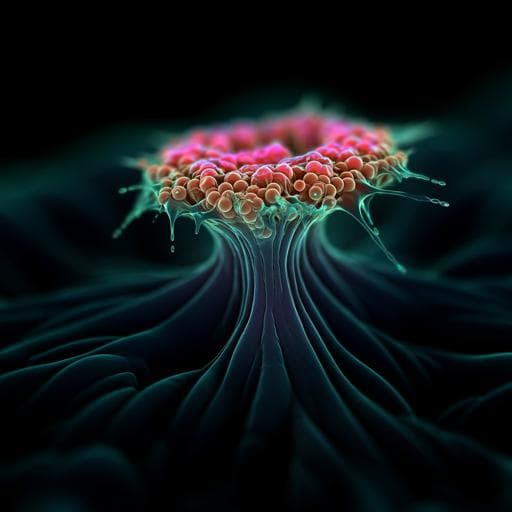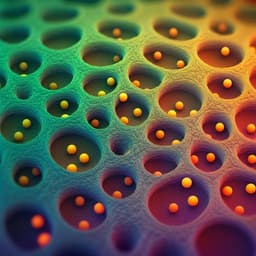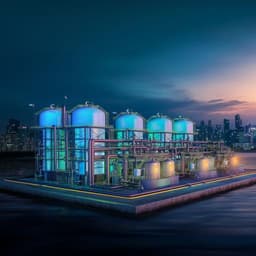
Engineering and Technology
Force-triggered rapid microstructure growth on hydrogel surface for on-demand functions
Q. Mu, K. Cui, et al.
This research introduces an innovative force stamp method to enhance microstructures on hydrogel surfaces through a unique polymerization mechanism. This advancement allows for rapid modification of hydrogel surface properties, paving the way for targeted applications like controlled cell growth and water droplet manipulation. These exciting findings were achieved by a team of researchers including Qifeng Mu, Kunpeng Cui, and others from Hokkaido University.
~3 min • Beginner • English
Introduction
The study addresses how to achieve rapid, spatially controlled growth of functional microstructures on hydrogel surfaces using mechanical force as a trigger, inspired by biological surfaces (e.g., cactus spines and cephalopod skin) that form functional surface structures via growth. Prior approaches relied mainly on light/heat-triggered chemistry. The authors hypothesize that mechanochemical reactions in double-network (DN) hydrogels can be harnessed at the surface to initiate radical polymerization of fed monomers, enabling on-demand surface morphology and chemistry without catastrophic failure. A key challenge is that conventional hydrogels fail upon limited bond scission and typical DN hydrogels prepared on glass have a soft second-network surface layer lacking the DN effect at the topmost interface. The purpose is to realize controllable, efficient force-triggered polymerization confined near the surface by engineering DN hydrogels with a proper surface DN structure and to demonstrate functional outcomes such as cell guidance and droplet transport.
Literature Review
The paper situates the work within mechanochemistry and surface patterning of polymers: prior work demonstrated light-irradiation-induced growth of microstructures on polymer surfaces and numerous molecular mechanisms for force-triggered reactions, including bond scission generating mechanoradicals that initiate polymerization. However, translating these mechanisms to bulk hydrogels is difficult due to catastrophic failure upon minimal bond breaking in conventional gels. DN hydrogels overcome this by distributing stress via a soft second network, enabling controlled, high-efficiency mechanoradical generation correlated with applied stress/strain. Previous studies also noted that DN gels prepared on glass possess a soft second-network surface layer due to electric double layer effects, impeding surface DN behavior. The authors leverage prior understanding of DN mechanics, mechanoradical polymerization in bulk, and surface preparation methods (hydrophobic molds) to enable their approach.
Methodology
- Materials and DN hydrogel design: Conventional DN hydrogels comprising a highly crosslinked, prestretched brittle first network of poly(2-acrylamido-2-methylpropanesulfonic acid sodium salt) (PNaAMPS) and a sparsely crosslinked soft second network of polyacrylamide (PAAm), both crosslinked with N,N'-methylenebisacrylamide (MBA). Density functional theory suggested possible C–C bond scission sites at crosslinks or main chains in the first network.
- Surface DN preparation: To ensure a DN structure at the topmost surface (avoiding a soft second-network-only layer formed on glass molds), the second network was synthesized using a hydrophobic mold to prevent electric double layer formation. Surface composition and mechanics were validated by ATR-FTIR (presence of first-network chemical signals), surface elastic modulus measurements, and roughness (Ra ~0.9 µm), confirming DN character at the surface.
- Force triggering and monomer feeding: DN hydrogels were immersed in aqueous monomer solutions (e.g., N-isopropylacrylamide, NIPAm; sodium 2-acrylamido-2-methylpropanesulfonate, NaAMPS; acrylic acid, AAc; sodium p-styrenesulfonate, NaSS; 3-(methacryloylamino)propyl-trimethylammonium chloride, MPTC). Mechanical force was applied via macro- and micro-indenters (cylindrical, diameters 84–866 µm) to induce bond scission in the first network, generating mechanoradicals that initiated polymerization locally.
- Observation of polymerization: Rapid turbidity change upon indentation in concentrated NIPAm solution was recorded. Formation of hydrophobic PNIPAm in indented regions was confirmed using the hydrophobic fluorescent probe ANS at temperatures above PNIPAm LCST (~32 °C), showing fluorescent patterns at indented zones. Time-resolved near-infrared spectroscopy tracked monomer conversion over seconds for NIPAm and NaAMPS, indicating fast completion of radical polymerization.
- Indentation mechanics and process zones: Cyclic micro-indentation tests (in air) compared DN vs single-network PAAm gels. Mechanical hysteresis in DN indicated covalent bond rupture energy U_hyst; its dependence on maximum indentation depth L_max was quantified. Macro-crack formation at large L_max for small indenters was noted; subsequent analyses were restricted to non-cracking conditions.
- Microstructure characterization: After indentation in monomer solutions, samples were rinsed and allowed to reswell in water. A 3D laser microscope measured microstructure height (H) and diameter (D). Systematic variation of indenter diameter (d) and L_max established independent control of D (by d) and H (by L_max). Swelling kinetics were monitored; characteristic equilibration time was ~1 min for ~1000 µm-thick, ~600 µm-diameter process zones, indicating swelling—not polymerization—limits the observed height change timescale.
- Monomer scope and conversion: Conversion ratios were quantified via transmission NIR spectroscopy by comparing integrated peak areas before (S0) and after stretching (S1): η = (1 − S1/S0) × 100%. The effect of adding MBA crosslinker and varying monomer concentration on microstructure height was examined.
- Patterning: 3D-printed stamps with embossed micro-patterns were used as "force stamps" to generate complex PNIPAm surface patterns. Temperature-responsive fluorescence patterns (via ANS) were imaged and actuated through thermal cycles. Deformation of patterns under uniaxial stretching was observed.
- Biological application: DN hydrogels with PNIPAm or PDMA micro-stripe patterns were prepared. C2C12-GFP myoblasts were cultured at 37 °C for 5 days. Cell adhesion, alignment, and morphology on patterned vs control (damaged in water without monomer) surfaces were examined via bright-field and fluorescence microscopy.
- Wetting and droplet transport: DN surfaces with parallel PNIPAm lines oriented vertically or horizontally were prepared. Contact angle hysteresis (advancing vs receding angles) for 10 µL droplets on vertically oriented, horizontally oriented, and smooth DN surfaces was measured on vertically placed samples. Droplet transport velocity vs volume was quantified; critical volumes for onset of motion were determined.
Key Findings
- Rapid force-triggered polymerization: Indentation of DN hydrogels immersed in NIPAm solution produced visible turbidity within seconds; near-IR spectroscopy confirmed radical polymerization essentially completed within seconds for NIPAm and NaAMPS.
- Surface DN requirement: Using hydrophobic molds to form the second network yielded a DN structure at the topmost surface, enabling chemical modification at the surface. DN prepared on glass possessed a soft surface layer; even though internal fracture and swelling occurred at large L_max, no new polymer formed at the topmost surface there, confirming the necessity of removing the soft layer for surface chemical modification.
- Geometric control: For cylindrical micro-indenters (d = 84–866 µm), microstructure diameter D approximately equaled indenter diameter d and was insensitive to L_max; height H increased with indentation depth L_max and was largely independent of d. Thus, D and H can be independently controlled by d and L_max, respectively.
- Swelling-limited kinetics: Mechanoradical generation and polymerization occur during loading and finish within seconds; subsequent microstructure height evolution is governed by swelling, reaching equilibrium in ~1 minute for ~1000 µm-thick process zones.
- Monomer conversion and height: Monomer conversion ratios (η) measured by NIR: NaAMPS ≈ 80% (highest), NIPAm ≈ 69%, with AAc, NaSS, and MPTC lower. Microstructure heights depended on monomer type, with NaAMPS and NIPAm yielding larger H. Adding MBA crosslinker to monomer solutions did not significantly change conversion or H; H increased with monomer concentration and saturated at ≈60 µm in the presence of MBA.
- Stimuli-responsive microfeatures: PNIPAm- and PAAc-based microstructures exhibited reversible height changes of roughly 30–50% in response to temperature and pH cycles, respectively, while the bulk DN hydrogel remained insensitive, enabling surface-specific actuation.
- Complex patterns and reconfigurability: 3D-printed force stamps produced complex, high-resolution PNIPAm patterns with sharp boundaries. Fluorescent patterns (via ANS) could be thermally switched on/off repeatedly. Patterns deformed predictably under uniaxial stretching.
- Cell guidance: C2C12 myoblasts cultured on PNIPAm or PDMA micro-stripe patterns preferentially adhered and aligned along the functionalized patterns, with elongated morphology; control DN gels damaged without monomer showed random cell distribution, indicating chemical (not purely topographical) cues from the grown polymers drive guidance.
- Directional droplet transport: On vertically oriented PNIPAm-line patterns, the contact angle hysteresis for a 10 µL droplet (difference between advancing and receding angles) was ~15°, about half that on horizontal patterns or smooth DN surfaces, facilitating motion. Transport velocity increased linearly with droplet volume on vertical patterns (slope ~3.3 mm s⁻1 µL⁻1), whereas a critical volume of ~10 µL was needed to initiate motion on horizontal patterns and smooth surfaces.
Discussion
The results validate the central hypothesis that mechanoradicals generated by controlled bond scission in DN hydrogels can drive fast, spatially confined polymerization at the surface when an appropriate surface DN structure is achieved. By decoupling diameter and height control via indenter geometry and depth, the approach enables programmable fabrication of surface microstructures with tailored morphology and chemistry in seconds. The generality across monomers and the observed stimuli-responsive behavior demonstrate versatility. Functional demonstrations—cell alignment on PNIPAm/PDMA patterns and gravity-assisted directional droplet transport on anisotropic PNIPAm surfaces—show that the mechanochemical growth process provides surface-specific functionality without altering bulk properties, addressing limitations of light/heat-based methods and expanding the toolbox for hydrogel surface engineering.
Conclusion
This work introduces a simple, rapid, and spatially controllable force-triggered growth method to pattern hydrogel surfaces by leveraging mechanoradical polymerization in double-network hydrogels with engineered surface DN structure. The method achieves independent control of feature size parameters, supports diverse monomers, and yields stimuli-responsive microfeatures. Practical applications in cell guidance and droplet transport are demonstrated. Future work could expand monomer libraries (including biofunctional ligands), optimize patterning resolution and three-dimensionality, integrate with soft robotic systems for reconfigurable interfaces, and investigate mechanistic factors governing monomer-specific conversion and final topographies to further improve efficiency and precision.
Limitations
- Surface preparation constraint: Effective surface chemical modification requires DN hydrogels without a soft second-network surface layer (necessitating hydrophobic molds during synthesis). DN gels prepared on glass do not form new polymer at the topmost surface under force.
- Indentation limits: Small indenters at large depths can induce macro-cracks; analyses were restricted to non-cracking conditions. The minimum achievable feature size was limited by the experimental apparatus (d ≥ 84 µm).
- Height saturation: Feature heights saturated (~60 µm with MBA) despite increasing monomer concentration, indicating transport or kinetic constraints.
- Monomer dependence: Conversion ratios and resulting heights vary by monomer; detailed mechanistic understanding of substituent and polarity effects was not resolved and left beyond the scope.
- Swelling kinetics: The observable height development is limited by swelling timescales (~minutes), which may constrain throughput for certain applications.
Related Publications
Explore these studies to deepen your understanding of the subject.







